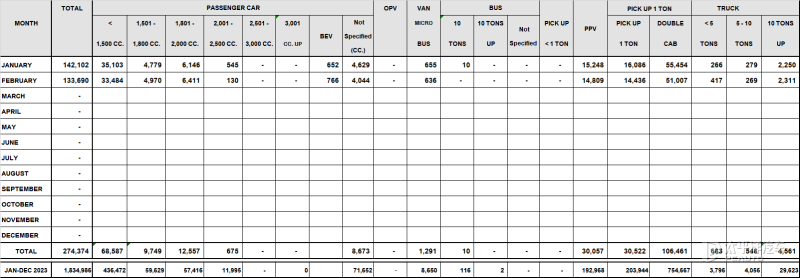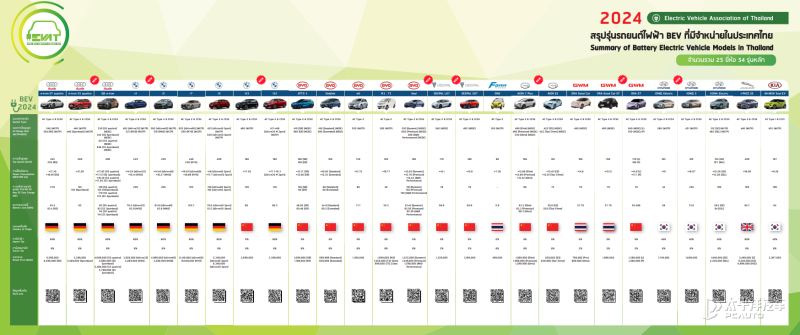Thailand's Automotive Industry: The Reason for Production Declined by 19.28% in February 2024
 AshleyMar 28, 2024, 02:33 PM
AshleyMar 28, 2024, 02:33 PM
On March 26, the Federation of Thai Industries said that the total automotive output in February 2024 was 133,690 units, a decrease of 19.28% compared to February 2023, and a decrease of 5.92% compared to January 2024. The reason was the decrease of export output and domestic sales output by 9.25% and 32.96% respectively.

The decrease in passenger car production and the market share being taken over by imported electric cars led to a decrease in domestic sales.
The production of pick-up trucks dropped, and the tightening of credit by financial institutions led to a decrease in sales. In January 2024, the total domestic car sales were 54,814 units, a decrease of 16.42% compared to January 2023. Due to family debt, the loan approval by financial institutions was strict. Data shows that the car loan rejection rate is as high as 50%.
1. The global chip shortage and supply chain disruptions continue to affect car production, leading to a decrease in exports. On April 12, 2021, Mitsubishi Motors of Japan mentioned that due to a chip shortage, the total production of three factories in Japan and Thailand will be reduced by 7,500 units in April 2021.
2. Foreign electric vehicles took up the market share in Thailand, leading to a decrease in domestic sales. According to Thailand's Top News report on December 18, 2023, the number of electric vehicles imported from various countries to Thailand has surged in the past 1-2 years, especially those imported from China. In 2022, Thailand's total imports of electric vehicles from China reached 14.626 billion baht. From January to October 2023, Thailand's import value of electric vehicles from China reached 69.657 billion baht, an increase of 826% compared to the same period last year.


3. The Russo-Ukrainian conflict broke out, affecting the global situation and car sales in Thailand. In April 2021, news of Russia's reinforcement at the Russo-Ukrainian border was frequent. Pyskov, a spokesman for the Russian presidential palace, said that if NATO sends troops to the Russo-Ukrainian border, Russia "will have to take additional measures to ensure safety".
Russia and Ukraine are important suppliers of auto parts. The war caused the related auto parts supply to be interrupted, such as xenon, palladium, wire harnesses, etc., affecting car production. The global chip shortage has not been alleviated, and the war has exacerbated the tension in the chip supply chain, delaying car production.
The war has caused global oil and natural gas prices to soar, and increased the cost of car production and transportation, which eventually pushing up the selling price of cars and further affecting car sales.
The Thai government attaches great importance to the development of electric vehicles in Thailand and has introduced many incentive policies. The EV3.5 policy is the second phase of the electric car incentive measures launched by the Thai government after the "EV3.0" policy, which was officially implemented on January 1, 2024, and lasted for four years.
For 2024-2025, the import duty on imported electric vehicles will be reduced to no more than 40%. For electric vehicles priced not more than 7 million Thai baht, the consumption tax rate will be reduced from 8% to 2%. At the same time, the government has set conditions to stimulate investment to support producers. Within 2026, compensation will be made according to the standard of 1:2 import ratio (import 1 vehicle, compensate 2 vehicles). By 2027, this ratio will further increase to 1:3.
If any infringement occurs, please contact us for deletion
Trending News

BYD Sealion 7 is not only cheaper than Tesla Model Y, what other differences do they have?
Is it better to buy the BYD Sealion 7 or the Tesla Model Y? This really makes one a bit hesitant, but before you make a decision, I recommend you take a good look at this article.

2026 Toyota Hilux Travo released, the brand-new exterior and interior are highly anticipated
If you're considering buying a Hilux, honestly, the comprehensive innovations in the ninth generation are worth waiting for. While the current model might still have some advantages in terms of reliability and price, the new model offers significant changes in terms of exterior and interior luxury, tech features, and powertrain options.

Toyota Land Cruiser FJ did not disappoint, the most anticipated civilian off-road vehicle is back.
Since its birth in 1951 under the name Toyota BJ, the Land Cruiser series has accumulated sales of approximately 12.15 million units in over 190 countries and regions worldwide, becoming a global off-road icon spanning more than 70 years.

In Malaysia, which sliding door MPVs are available?
The numerous advantages of sliding door MPVs make many people fond of this type of vehicle. However, MPVs are not a mainstream choice in the car market, so many people might not know which MPVs are available domestically.

Jaecoo J7 VS Honda CR-V, which is the most worthwhile C-Segment SUV to buy
With an exterior that closely resembles a Land Rover, Jaecoo J7's sales experienced several months of rapid growth but have recently slowed down. Perhaps the market is nearing saturation, as Jaecoo J7 has already surpassed the once-dominant Honda CR-V in the C-Segment SUV category.
Popular Cars
Model Year
Car Compare
Car Photo

